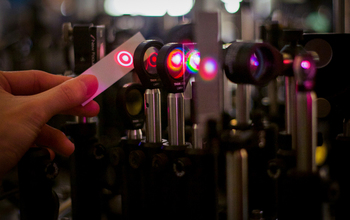Multimedia Gallery
Using laser light to tune electronic energy levels
Researchers at the Massachusetts Institute of Technology have discovered a new way of using laser light to tune electronic energy levels in 2D films of crystal.
More about this image
Faster, more efficient data storage and computer logic systems could be on the horizon thanks to a new way of tuning electronic energy levels in 2D films of crystal, discovered by researchers at the Massachusetts Institute of Technology (MIT). The discovery could ultimately pave the way for the development of so-called "valleytronic" devices, which harness the way electrons gather around two equal energy states, known as valleys.
Learn more about this discovery in the MIT news story Toward 'valleytronic' devices for data storage or computer logic systems. [Note: See "Restrictions" below regarding use of this image.] (Date image taken: unknown; date originally posted to NSF Multimedia Gallery: Dec. 11, 2018)
Credit: Jose-Luis Olivares/MIT
Special Restrictions: Images for download on the MIT News office website are made available to non-commercial entities, press and the general public under a Creative Commons Attribution Non-Commercial No Derivatives license. You may not alter the images provided, other than to crop them to size. A credit line must be used when reproducing images; if one is not provided below, credit the images to "MIT."
Images and other media in the National Science Foundation Multimedia Gallery are available for use in print and electronic material by NSF employees, members of the media, university staff, teachers and the general public. All media in the gallery are intended for personal, educational and nonprofit/non-commercial use only.
Images credited to the National Science Foundation, a federal agency, are in the public domain. The images were created by employees of the United States Government as part of their official duties or prepared by contractors as "works for hire" for NSF. You may freely use NSF-credited images and, at your discretion, credit NSF with a "Courtesy: National Science Foundation" notation.
Additional information about general usage can be found in Conditions.
Also Available:
Download the high-resolution JPG version of the image. (4.4 MB)
Use your mouse to right-click (Mac users may need to Ctrl-click) the link above and choose the option that will save the file or target to your computer.



